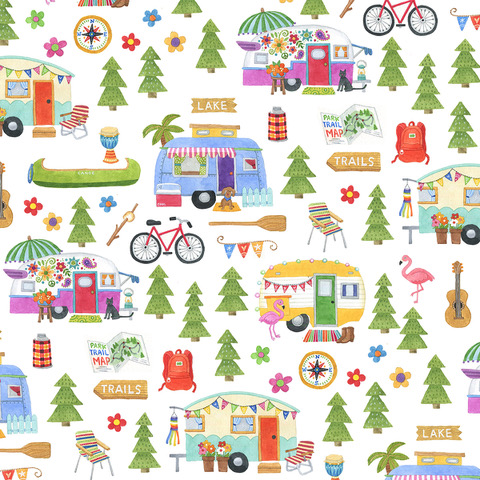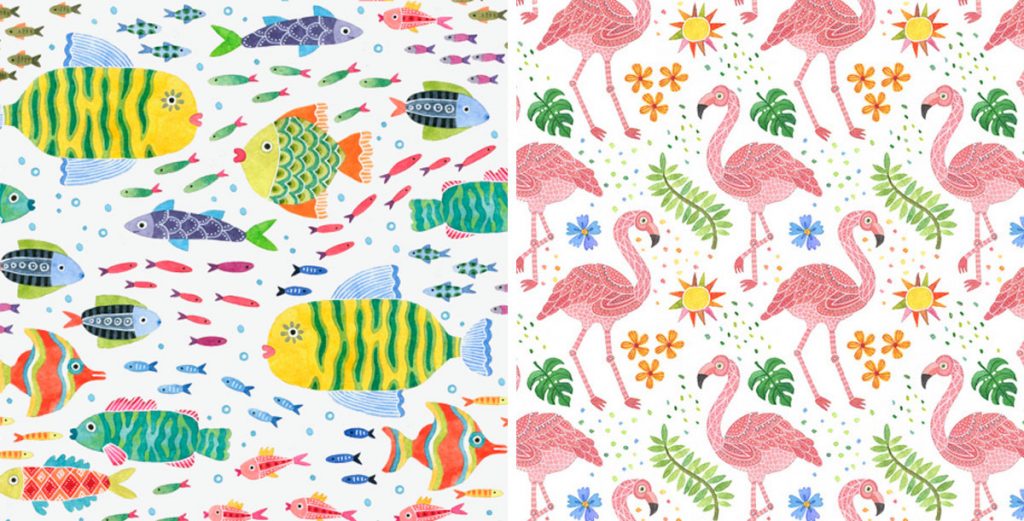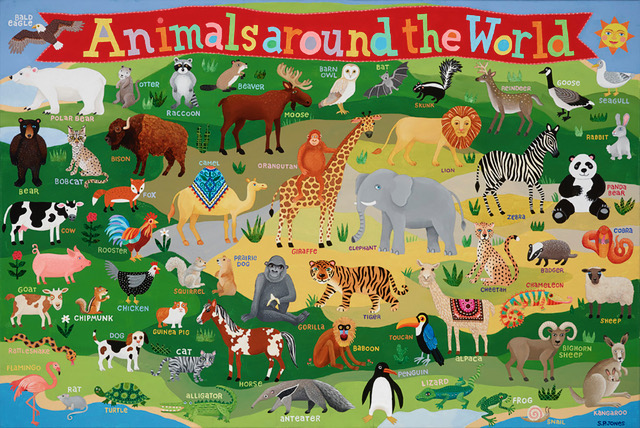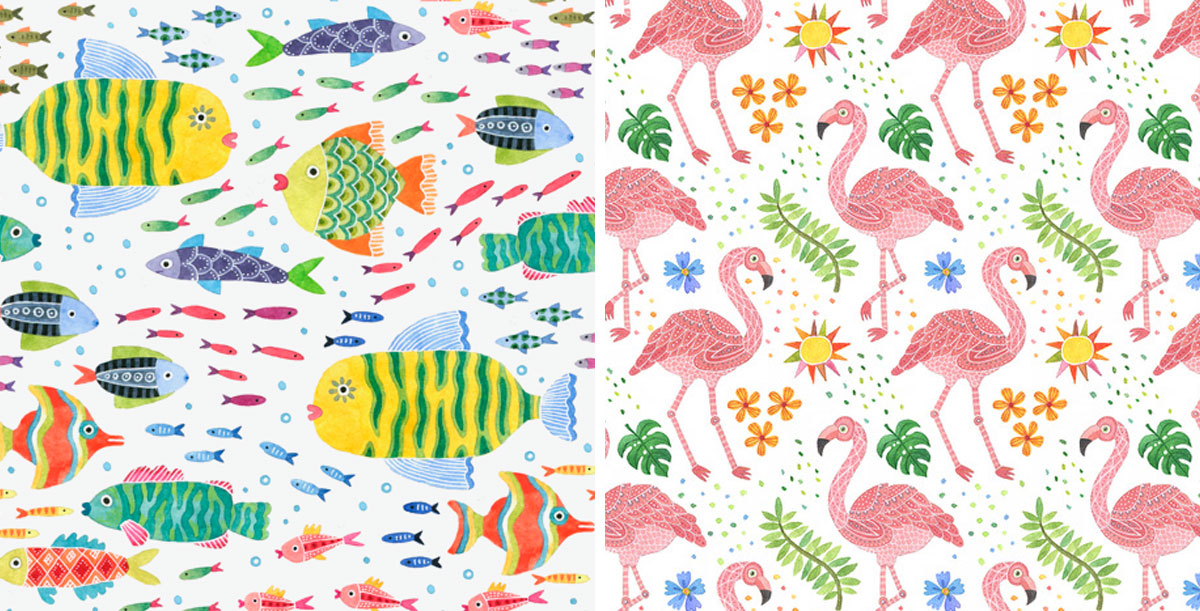This month we are delighted to welcome Stephanie Peterson Jones to the Textile Design Lab as our guest expert. Stephanie and I both live in Asheville, NC and it has been wonderful getting to know her over the past year!
Stephanie is a talented children’s illustrator who licenses her artwork for products such as books, cards, calendars, puzzles and more. She is also the author of Drawing for Joy, “a one year program for the beginning artist formatted as a fun and creative progression of daily prompts.”
We are so excited to bring Stephanie’s wealth of experience to the Textile Design Lab guest expert role. On Tuesday February 26th, Stephanie will be in the Lab sharing her thoughts on meditation, drawing, creativity and working in this inspiring industry. We invite you to learn more about Stephanie in today’s interview!
Please tell us a bit about your design background and career path.
The artist seed was planted as a child. I was fortunate to be brought up in a neighborhood where all the kids would sit around a coffee table and draw for fun. In college, I had almost enough credits for a degree in Graphic Design but left to go to NYC and study illustration at Parson’s School of Design, and would take the train once a week from CT. This brings to mind the song, “The long and winding road….”. My career path evolved in response to what was and wasn’t working at the time, which is how it has gone for me. Some people are so clear about exactly what they want to do and don’t waver, but that’s not how it’s gone for me. I spent a few years in Corporate America as a graphic designer, and I started getting freelance illustration gigs. One was a weekly grocery store ad which I created the illustration and lettering for. It was a steady gig for 7 years so enabled me to become a full-time freelancer. Eventually I signed up with Cornell & McCarthy (now Cornell & Co.), a children’s illustration agency and they provided me with a lot of great work in educational publishing and kids books. I also started licensing with an agent and did Surtex twice, which was great fun. and I met a lot of people there, both artists and clients.
During those years I did a lot of freelance work with C.R. Gibson. I took over an art director position there for someone going on maternity leave, which was a lot of fun and I learned so much there. They gave me a lot of illustration work too and became a very long term client. I also illustrated Peek-a-Moo in 1998, which became a huge hit, and has been reprinted over 25 times and in several languages too!

Along with the licensing came burn-out, because I was always trying to create exactly what the client was looking for and meanwhile keeping up with the latest trends. I was living in Boulder, CO and had developed a passion for Pilates, and decided to train to be a Pilates Instructor. I moved to CT and got married, and for the next ten years I ran a small boutique studio. I did a few children’s books during that time but not too much illustration, and eventually I missed art. I decided to follow a life-long dream and become an art teacher. I finished my degree and enrolled in a teacher certification program, sold my Pilates Studio but still continued to teach. I taught in the public schools for a couple of years part-time, and it wasn’t easy for me. My independent and entrepreneurial nature didn’t fit in with the public school’s bureaucracy. When my husband and I moved to Asheville, NC I decided to commit to being an artist again, but I made some changes.
Rebooting my art career these past few years hasn’t been easy. The economy was suffering and the internet affected both what and how people were buying. I reached out to some of my former clients who gave me work but often the fees were smaller than in the past and it’s been harder to land a licensing deal. I produced some speculative work, and those ideas have turned into wall art and puzzles that are licensed to the likes of Target, Sam’s Club and TJMaxx. I also connected with Quarto (publishers) and presented a book idea which became a book that I wrote and illustrated called Drawing for Joy. Facebook and Instagram have become a great source of connecting with other artists and art buyers and I’ve grown an etsy site by posting there.
After three years I decided to open a studio/gallery in the River Arts District in Asheville. It’s been really nice getting to know other local artists, and meeting the tourists who come and visit the studio. I sell paintings and prints here, as well as my books and puzzles. I also have some print on demand products that I also sell on etsy such as flash cards, tea towels, pillows and t-shirts.
Things seem to be going well now, and I am happy. In addition to having my studio, I teach Pilates one day a week, and have a fellowship with Arts for Life, for who I am creating an art program in the adult oncology department.
Currently I am completing final illustrations for a journal for Peter Pauper press, preparing presentations of fabric design for Robert Kaufman, and creating artwork to be licensed with Metcolors. I am also pursuing clients who I met at the Atlanta Gift Show in January. I am also getting ready for Blueprint, where I will be showing my art with a friend and art agent, Lisa Larsen.

Tell us about your design process. What media/design tools do you like to use? What are your go-to sources for design inspiration? (Any books, websites, magazines, etc. that you would recommend)
I like to use traditional media for my illustrations and paintings; watercolor or acrylics and lots of black and white pens. When I first moved to Asheville I did a lot of line art for the adult coloring market and I fell in love with fountain pens. Sometimes I add collage and block printing to my paintings. I love recycling materials so I use clippings from magazines and found paper. I scan my work and make adjustments, or combine backgrounds with foregrounds, and put things into repeat, using Photoshop and Illustrator. I bought an ipad Pro last year, and made a new year’s resolution to learn Procreate this year.
I am inspired quite a bit by ethnic patterns and folk art. You will see it in my style and there are almost always patterns involved in my work. I am inspired by artists who incorporate lots of pattern and color in their work. I’ve always loved surface pattern. My mother was a seamstress and I loved to pick out fabric for her to make my dresses. We’d go to the fabric stores and look at the rows of bolts of fabric and I loved the colors and patterns. I loved Merrimekko. I wanted them all.
I love to look at Pinterest. When I am working on a particular theme, I find a lot of good reference material there and also refer to my collection of art and reference books. I love Uppercase magazine for eye candy, a magazine highlighting my peeps.
An important part of my day I call “my daily meditation”. This started as a practice I developed in graduate school that consists of meditation followed by a short period of art making. When I wake up (I am an early riser), I grab a beverage and go to my studio. Using watercolors on Strathmore 500 postcards, I paint and draw with a focus on mindfulness and flow (mental state of complete absorption in the current experience). The image can be completely freeform but sometimes I am inspired to do an animal or pattern. I breathe as I meditate through the process and intentionally let go of my thoughts along the way. When I first started this process I committed to 15 minutes of art making. Lately, I might take up to an hour or more, depending on the day ahead of me. My daily meditations often lead to paintings or illustrations.

Could you talk about your experience with buyers in the illustration market and what they are looking for? What can designers do to stand out?
I think that buyers of illustration are looking for a fresh new look. Finding your unique voice as an artist, and sticking with it is the best way to stand out. The burn-out I experienced years ago was the result of trying so hard to please my clients that I wasn’t focusing enough attention on if the art represented me. One way this happened was that I was creating art for products that I didn’t believe in environmentally, to a point where it took the joy out of the process. Spend some time regularly making work that is just for you. When you are true to yourself, your work will feel joyful, and that energy will appeal to both you and your clients.
Art buyers are super busy, and are contacted daily by many artists. One of the best things you can do to stand out is to show your work mocked up on the potential client’s product. Be professional, cheerful and easy to work. If you can make it easier for a client to see how your work will enhance their product, you will be ahead of the game.
The illustration I do is primarily for the gift, stationery, fabric and children’s markets. I attend Gift Shows, Surtex, and the Stationery Show to seek out clients, connect with my peers (so much fun), and identify trends. Most of my success finding the right clients has happened when I approached them. The reason this has worked is because I expressed passion about what they do and also show confidence that my artwork will make them shine.
Since I was essentially out of the business for over 10 years, these last few years I have focused on developing my portfolio, creating collections that are current to show to potential clients. I do a lot of speculative work, which is good and not good. The good part is that you get to create exactly what you want from the theme to the style. The not so good part is that you can also end up spending a lot of time doing work that will never be licensed or used, which is frustrating and exhausting.
What have been some of the challenges you have faced throughout your design career and how have you overcome them?
One of the experiences that put me over the edge was a client who hired me to illustrate a complex children’s book with flaps and dials. They had me do sketches and each time I handed them in, there were major revisions in the book’s format, and I had to start from scratch each time. I realized that I was being used to help them figure out the format of the book, meaning, they had no idea of what they wanted before putting me to work. There was nothing in the contract specifying compensation for these major revisions and each time it required many hours of additional work. My agent eventually negotiated some extra money, but a lot of damage had been done along the way. So when you negotiate a contract, make sure there are provisions in place for every possible circumstance.
It seems that more and more companies are asking for art for licensing deals without providing an advance. Licensing art can be profitable, but not always and sometimes a flat fee is the better way to go. This is a complicated topic, but I would suggest that you find out the company’s plans for distribution, and do the math, before accepting their proposal. Insist on some payment up front. I’ve had disasterous outcomes with prominent companies that have severely affected my ability to pay my mortgage.
I’ve been fortunate to work with good agents who have stood up for me, and I have learned from them to leave my emotions out of business as much as possible. I am far better now at standing up for myself, negotiating contracts with kindness and calmness, and walking away if necessary. I used to feel that I needed an agent to handle my contracts so that I could stay separate, and maintain the joy I needed to make artwork, but now I feel like I can handle contracts for myself most of the time.
Having consistent income can be a challenge as an illustrator. You never know what to expect from your licensing contracts and often your payments don’t come when expected. Many artists have several sources of income to balance the irregularity of a freelancer’s pay. It can be teaching, having an etsy shop, a part-time job at Starbucks, or something completely unrelated. I am ever grateful for my Pilates training which helps me maintain consistency of income.
What inspired you to create your book, Drawing for Joy?
As I mentioned before, when I was in graduate school I did a daily art and meditation practice which was designed to see whether meditation practice before art making would create a more mindful, flow art making experience for me. After doing this for 3 months, and writing about the results, I realized what a profound impact meditation had on my art making. With the intention of being in the present moment, art became meditation. This is what became what I call “my daily meditation”, which I still continue to do almost every day.
I was so moved by this experiment, and excited about the results, that I started to write a proposal for a book about art and meditation. I worked on it occasionally, but it mostly sat in a pile on my desk. When I finally sent it in in January 2015, it was accepted!! The book changed some from what I proposed, and is a book for beginners about having a daily art practice. It includes daily prompts and art starts, guiding the reader to draw for 15 minutes daily, improving with the addition of skills and practice, over the course of a year.
Can you tell us a bit about your meditation practice and how that affects your work as an artist?
Like so many people, I can be my own worst critic when it came to making art. I felt like an imposter and that I was fooling the world and one day soon, I’d be found out. My art wasn’t a reflection of my most authentic self, and I felt like I was running to keep up rather than growing. When I had a chance in graduate school to design a culminating project, this is what I came up with.
Since I have been doing my “Daily meditation” since around 2012, it has evolved from a separate meditation and art making time to a combined one, where I put watercolor on a postcard while incorporating meditation practices of mindfulness, breath and letting go of all thoughts. This keeps me in a flow experience.
Having this practice in my life is the best thing I do. It gives me a period of time every day that I am completely myself. I am not in a critical mindset, as a matter of fact, I have no expectations at all for what I am making. It’s fun and relaxing. That spills over into my regular art making time, which has flow, and where I am more able to let go of expectations. A nice outcome of practicing anything with that kind of regularity is that it also helps you improve at that thing, without trying. It’s just a result of doing it all the time.

What
advice have you received in your career that has stayed with you or
influenced you? Do you have any words of wisdom for aspiring designers
trying to build successful careers of their own? Any advice for
designers hoping to break into illustration in particular?
One of the most important and memorable things that has stayed with me was a portfolio meeting I had with a potential client. The art director was looking through the pages of my portfolio with genuine interest, and asked me questions along the way. At the end of the meeting he said that he loved my work, but it wasn’t the right fit for his needs. The way he said it hit home and I got the important lesson that you will never be a fit for everyone, and that is perfectly OK.
Get to know people in your industry: other artists, agents, printers, manufacturers. The people you know are really important, they become your friends, and your people who live a similar life to you. They can all be wonderful resources. And you never know who might refer you to some wonderful client.
Another thing I would say is that timing is important. Don’t give up on a potential client if they say no once, or even twice. Having your work show up in front of them regularly will make you easy to reach when it’s the right time.
I would also say that I think it’s important to have a side hustle that you can depend on, if you need the income. I am the kind of person who has a lot of interests so for me it’s somewhat easy to figure out. But more importantly, it can really help you when you need it to.












